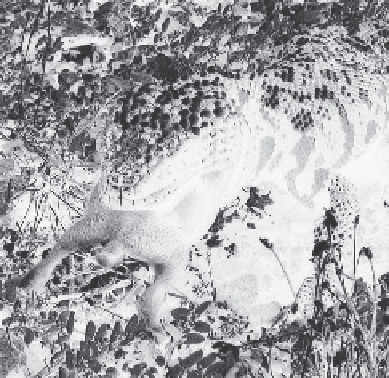Environmental Engineering Reference
In-Depth Information
(a)
(b)
FIGURE 9.13
Gila monsters in the northeastern Phoenix metropolitan area can be observed crossing roadways (a) while
searching for prey such as cottontail rabbits (b). (Courtesy of Roger Repp.)
persist (like the common chuckwalla), suggesting that habitat structure rather than vegeta-
tion composition is important for reptile species.
82
Similar habitat associations have been
detected for Sonoran Desert birds in Tucson: they generally respond to percent cover in
areas whether they are urbanized or natural, rather than simply avoiding urban areas.
86
The Gila monster is a long-lived predatory lizard that feeds on birds (eggs of ground-
nesting species) and mammals (rodents, neonatal rabbits), prey species that are increasingly
abundant in human-altered landscapes (Figure 9.13).
21
Some small carnivores, such as
long-tailed weasels, have smaller ranges in urbanized settings due to greater availability
of prey and restrictions on movement due to barriers.* Tiger rattlesnakes in the Tucson
region have larger body size and higher reproductive output, and smaller home ranges,
near golf courses, apparently due to increased numbers of rodent prey.
87
By contrast, a
recent study was unable to document a change in home range size or movement behavior
of Gila monsters in response to modest levels of habitat fragmentation and increased
availability of prey species in the Phoenix region. Given that Gila monsters have much
larger home ranges than common chuckwallas (10-100 times larger) and often make
use of human structures as refuges in spite of the availability of natural refuges nearby
(e.g., woodrat nests), they are more likely to experience injury or death while crossing
roads, which they do with regularity.
21
Surveys of Sonoran Desert snake communities near
*
See review in Kwiatkowski et al.
21



Search WWH ::

Custom Search